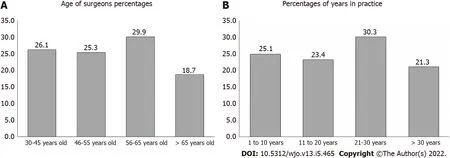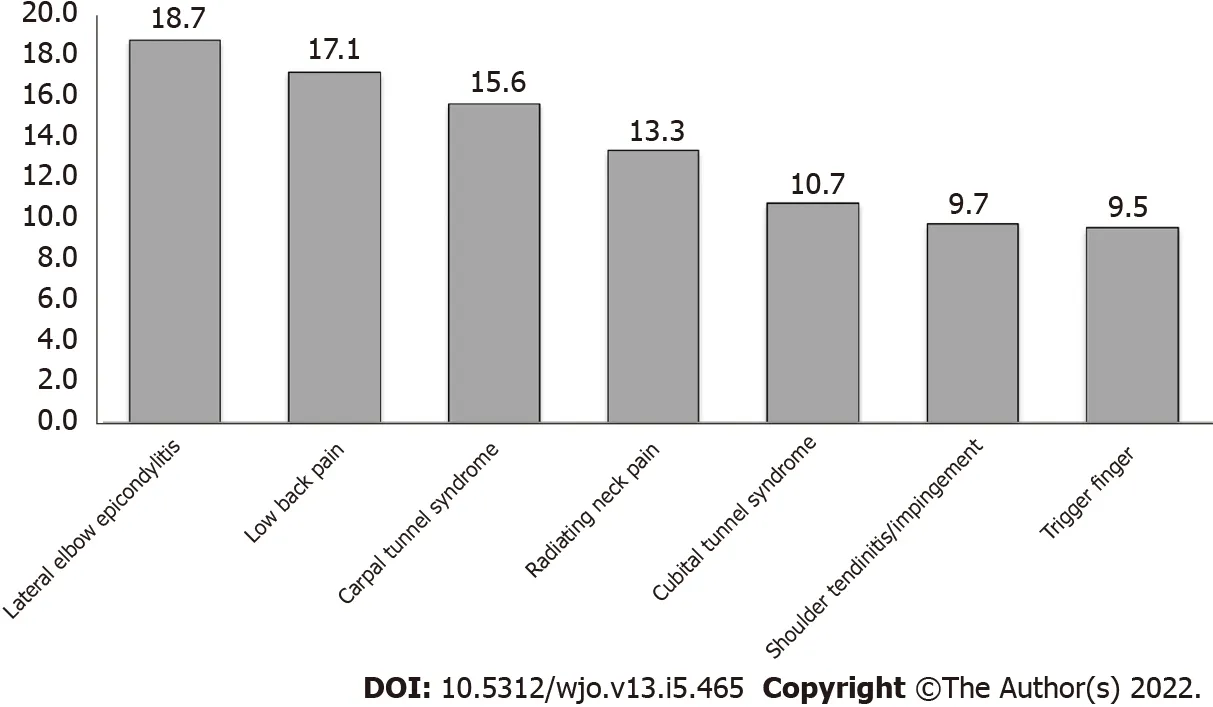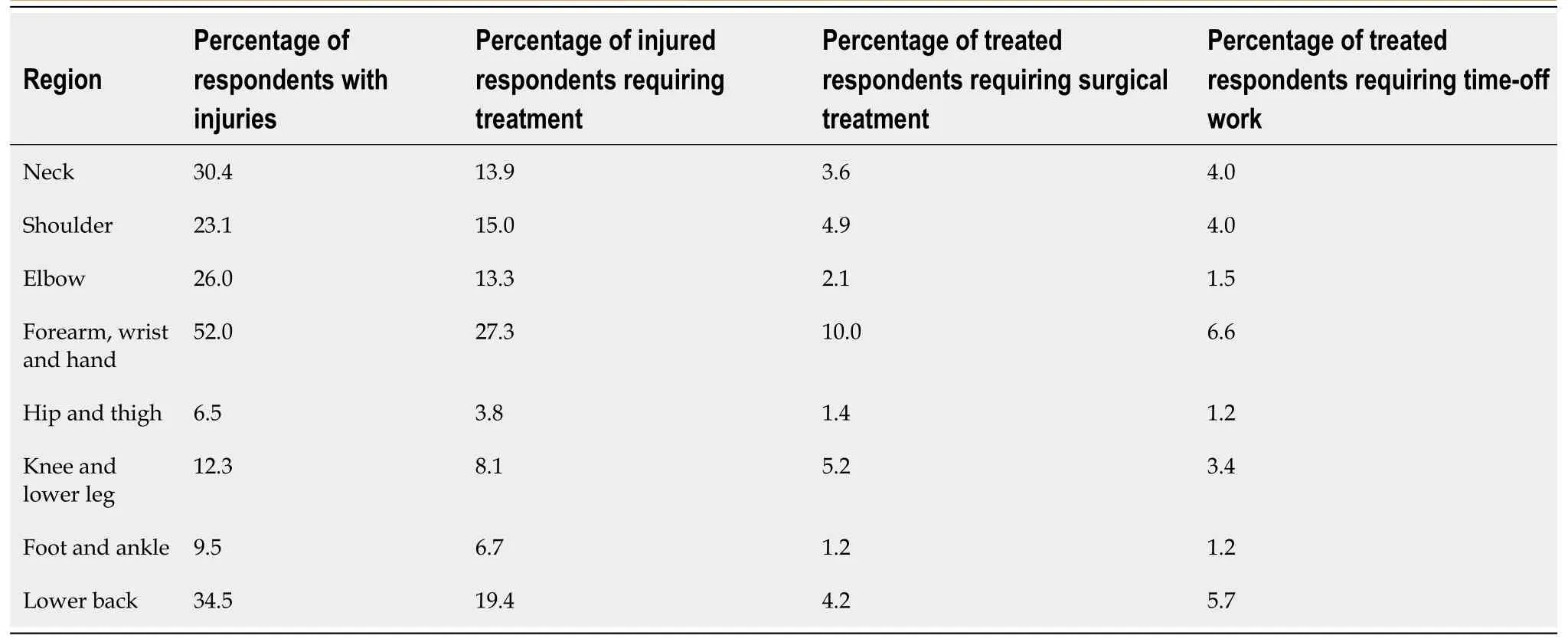Prevalence and factors of work-related musculoskeletal disorders among hand surgeons
lNTRODUCTlON
Occupational injuries have gained recent attention in the medical literature, with studies exploring the prevalence of these injuries and possible predisposing factors. While all physicians are at risk of sustaining these injuries, surgeons have been identified as a high-risk group[1-6].
It was a rainy Monday. I was supposed to cross the road, when I hear a BLAAGGGGGGGG... Someone behind me trying to push me because the car would hit me...The guy was hit. I was so shock I can’t figure it out! My heart felt trembling1(,) down. I don’t know were I’m going because after the accident I was walking far from the incident2. I’m walking without direction. Until I found myself standing3 beside the man looking like an angel4. I never thought that the man save my life is the man in my dream.
Musculoskeletal (MSK) disorders have been identified as a common occupational risk for surgeons,which has been referred to as “an impending epidemic”[1]. Their risk of occurrence increases especially when the surgeon in involved in tasks requiring repetitive and forceful movements, as it has been found that the prevalence of these injuries was more than 60% in practicing orthopaedic surgeons of different subspecialties[3-5,7-9]. These injuries involved multiple MSK regions, including the lower back, elbow and wrist, thus requiring a large cohort of these injured surgeons to take time off work as a direct result of their sustained injuries.
Awareness of these MSK disorders and improvements in operative room ergonomics may have a substantial effect on the prevention of their occurrence[10-12]. Unfortunately, this effect isn’t evident from the most recent literature, possibly due to the difficulty in applying some of the proposed ergonomical alterations and recommendations in the operative field[10,13,14].
A modified version of the physical discomfort survey was sent to surgeons who were members of the American Society for Surgery of the Hande-mail. The collected data were analyzed using descriptive statistics, one-way analysis of variance, and Fisher's exact test.values of < 0.05 were considered statistically significant.
MATERlALS AND METHODS
Of the 578 respondents, 60.4% reported that they had sustained a work-related musculoskeletal injury,of which the most common diagnoses were lateral elbow epicondylitis, low back pain and carpal tunnel syndrome.
Questions pertaining to the surgeons general demographics (, age, gender, hand-dominance, type of practice, number of years in practice and annual caseload), in addition to questions exploring work related MSK injuries were included in the survey. The explored MSK injuries were divided into anatomical regions, including neck, shoulder, elbow/forearm, wrist/hand, hip, knee, foot and ankle,low back. In addition, participants were asked about both treatment required and time off work required due to the reported injuries, if any.
Statistical analyses
The collected data was analyzed using descriptive statistics, one-way analysis of variance, and Fisher's exact test using SPSS statistical package version 24 (SPSS Inc., Chicago, IL).values of < 0.05 were considered statistically significant.
RESULTS
Five hundred and seventy-eight surgeons completed the survey, with a respondent rate of 16.5%. The majority of respondents were males (84.8%), while 15.2% were females. More than half of the responding surgeons were younger than 55 years, while most have been in practice less than 30 years(Figure 1A and B). The vast majority of surgeons were practicing in an academic, community or private institute.
She caught sight of Kay; she recognised him, and ran and put her arms round his neck, crying, Kay! dear little Kay! I have found you at last! But he sat quite still and cold

Among those that reported an injury, 73.1 % required treatment, of which 11.8% required surgical management only, while 31.5% required both surgical and medical management for their injuries(Table 2). The need to undergo treatment or take time off due to the injury was associated with increased number of injuries (< 0.001). In addition, surgeons were more likely to receive surgical treatment when they were > 56 years of age (< 0.001) or had been in practice for > 30 years (< 0.001).
I was to get a pony4, but before we could even start looking, I had to live up to my end of the bargain. I had to try to talk. I had a chart of weekly tasks I had to accomplish. I had to answer the phone five times per week, something I had never done before. I had to make five phone calls to my friends. I had to say one word to my teacher at school and the list went on. For a child with Selective Mutism, saying one word to someone can be like climbing Mount Everest.
Several months later, the director of the orphanage was on furlough in the United States. He wanted to visit all the churches that supported him in China, so he came to speak on Sunday night at my grandfather’s small church in Chicago. Grandpa and his family sat in their customary seats among the sparse5 congregation.


Concerning work related injuries, 60.4% reported that they had sustained a work-related MSK injury(Table 1), of which the most common diagnoses were lateral elbow epicondylitis (18.7%), low back pain(17.1%) and carpal tunnel syndrome (15.6%) (Figure 2). The number of work-related injuries incurred by a surgeon increased significantly with increasing age (< 0.003), increasing years in practice (< 0.001)and higher case load (< 0.05). No association was found between sustained injuries and sex, hand dominance, nor type of practice.
Increasing age and years in practice were associated with the number of reported injuries in our cohort. We also found that surgeons with a higher case load were more likely to report a work-related MSK injury. Alqahtani[5] and Alzahrani[7] also found that increasing age and number of years in practice were independently associated with the number of reported MSK injuries in both the orthopaedic trauma and pediatric surgeon populations. In a study of 183 orthopaedic adult reconstruction surgeons, age > 55, practicing for > 20 years and increased case load were found to be associated with requiring time off work due to the sustained injury, but they found that these variables were not associated with the number of reported injuries[4]. In our cohort we found similar results, as time off work was more likely in surgeons older than 56 years and surgeons who have been in practicefor more than 21 years.

DlSCUSSlON
We assessed the prevalence of work-related musculoskeletal injuries sustained by hand surgeons during their career. We found that of those responding to a survey, a high proportion of these surgeons (60.4%)reported a musculoskeletal injury sustained during work. A number of previous studies have assessed this prevalence in different specialties, as Davis[3] reported a 44% prevalence of these work-related injuries in the general orthopaedic surgeon cohort. Specifically, Alqahtani[4,5] surveyed both the orthopaedic adult reconstructive and the orthopaedic trauma surgeon cohorts and found a similar prevalence of 66% in both studies. Alzahrani[7] found that 67% of the 402 orthopaedic pediatric surgeon respondents reported that they sustained a work-related MSK injury.
The most common injuries reported by the surveyed hand surgeons in our cohort were lateral epicondylitis (18.7%) and low back pain (17.1%). We also found a high prevalence of carpal tunnel syndrome which was reported by more than 15% of the respondents. These common pathologies were similar to the previously published studies in different specialities, as low back pain and elbow injuries were the most common reported injuries by the surveyed surgeons.
When the Prince and the golden mermaid, with the wolf behind them, mounted the steps of the palace, the Emperor came forward to meet them, and led them to the throne room
Of the respondents, 29.2% needed time off work as a direct result of their injury (Table 2). We also found that surgeons were more likely to require time off work when they were > 56 years of age (<0.001) or had been in practice for > 21 years (< 0.001).
Then he also heard the priest offer up a prayer of thanksgiving because the land had been freed from war and pestilence, and from all misfortune, and the king s daughter delivered from the evil one
When the saint saw that the prince was not to be moved, he said: Learn and know, O youth! that Waq of Qaf is in the Caucasus and is a dependency of it
Identifying this high prevalence of MSK-injuries in practicing surgeons (who responded to the survey) is the first step in exploring factors that can be implemented to aid in reducing the risk of sustaining such injuries. Operative room ergonomics has been identified in recent studies as an area that requires significant improvement, especially in surgeon postures and movements[10,14,15]. These include the use of specific body supports to improve posture and lower extremity compressive stockings to decrease the edema especially in long anticipated cases[13,16]. In addition, making use of certain power tools for screw insertions can help decrease the burden of the repetitive forceful movements required in this this surgeon population[8]. As these factors have been found to possibly improve the surgeons experience in the operating room and decrease the risk of sustaining injuries, we believe that increased focus should be directed to exploring the true effect of these recommendations, in addition to identifying other modifications that may be of benefit to the surgeon and the healthcare system in general in preventing the occurrence of such work-related MSK injuries.
We believe that our study has some limitations that are common with these types of prevalence studies. Recall bias is always a risk in surveys that depend on the respondents ability to recall events or factors that occurred in the past. In addition, while the majority of the surgeons identify their injuries as work-related, other factors that may have come into effect cannot be ruled out. Another weakness is that the survey used was not assessed for validity or reliability, especially the included self-reported measures. It is possible that some deficiency can be identified is such types of surveys, but a validation study would be required to explore these possible missed indicators and can be an area for future research.
CONCLUSlON
Our current study has shown a high occurrence of work-related MSK injuries sustained by hand surgeons. Increased awareness and preventative measures are key to minimize the financial and psychological burden on these surgeons and the healthcare system. To our knowledge this study is the first of its kind to assess these types of injuries is this surgeon sub-specialty.
ARTlCLE HlGHLlGHTS
Research background
Common tasks required by hand surgeons need both forceful and repetitive maneuvers, which can subject these surgeons to the risk of musculoskeletal injuries during their years in practice.
As I rubbed() alcohol on her arm to prepare it for the intravenous line, Rebekah laughed nervously7. I have to tell you I m terrified of needles. It ll be over before you know it, I said. I ll give you a count of three.
Research motivation
These injuries can place a physical and psychological burden on the surgeon, which can in turn affect the healthcare system. Therefore, attention should be directed at studying their prevalence and associated factors.
Research objectives
The objective of the study was to assess the prevalence, characteristics and impact of musculoskeletal disorders among hand surgeons.
Research methods
We conducted a study exploring prevalence of work-related MSK disorders among hand surgeons,with a goal to identify specific factors predisposing to these injuries and their impact on the surgeon’s practice. Also, we aimed from this study to increase awareness of these types of injuries both to the practicing surgeon and members of the healthcare system in general.
Research results
Members of the American Society for Surgery of the Hand were sent a modified version of the physical discomfort surveye-mail. The initial email was sent in June 2016, followed by a reminder email in December 2017, and survey collection was closed by June 2017.
Research conclusions
We have shown a high prevalence of musculoskeletal disorders among hand surgeons, with more than half of the surveyed surgeons reporting a sustained injury.
Research perspectives
These results should increase awareness on this aspect and fuel future studies directed at preventing these types of work-related injuries, thus minimizing the financial and psychological burden on these surgeons and the healthcare system.
FOOTNOTES
Alqahtani SM and Alzahrani MM contributed to the concept, design, study execution,manuscript writing and review; Bicknell R and Pichora D contributed to the concept, design, manuscript writing and review.
Not applicable as this was a survey.
Not applicable as this was a survey.
None conflict of interest pertaining to current study.
No additional data are available.
The authors have read the STROBE Statement - checklist of items, and the manuscript was checked according to the STROBE Statement - checklist of items.
Jurgen remained in merchant Bronne s house. He was hurt whileendeavouring to save our child, said the old man, and now he isour son. People called Jurgen insane, but that was not exactly thecorrect term. He was like an instrument in which the strings are looseand will give no sound; only occasionally they regained their powerfor a few minutes, and then they sounded as they used to do. Hewould sing snatches of songs or old melodies, pictures of the pastwould rise before him, and then disappear in the mist, as it were, butas a general rule he sat staring into vacancy, without a thought. Wemay conjecture that he did not suffer, but his dark eyes lost theirbrightness, and looked like clouded glass.
This article is an open-access article that was selected by an in-house editor and fully peer-reviewed by external reviewers. It is distributed in accordance with the Creative Commons Attribution NonCommercial (CC BYNC 4.0) license, which permits others to distribute, remix, adapt, build upon this work non-commercially, and license their derivative works on different terms, provided the original work is properly cited and the use is noncommercial. See: https://creativecommons.org/Licenses/by-nc/4.0/
Canada
Saad M Alqahtani 0000-0002-9925-2480; Mohammad M Alzahrani 0000-0003-1299-1529; Ryan Bicknell 0000-0001-9321-980X; David Pichora 0000-0002-3234-118X.
Wang JL
The guy was devastated10, as it was a complete loss. Why did fate played such cruel games with him? He cursed the heaven for taking her away from him, denying even one last look at her! How cruel he cursed! How he damned the God!! How he hated himself... for taking so long to realize his mistake!! That was in 1996.
A
Wang JL
 World Journal of Orthopedics2022年5期
World Journal of Orthopedics2022年5期
- World Journal of Orthopedics的其它文章
- Coronal plane deformity around the knee in the skeletally immature population: A review of principles of evaluation and treatment
- Update in combined musculoskeletal and vascular injuries of the extremities
- lnsufficient lateral stem contact is an influencing factor for significant subsidence in cementless short stem total hip arthroplasty
- Distal femur complex fractures in elderly patients treated with megaprosthesis: Results in a case series of 11 patients
- What factors are important to new patients when selecting an orthopedic oncologist?
- Anterior vertebral body tethering for idiopathic scoliosis in growing children: A systematic review
